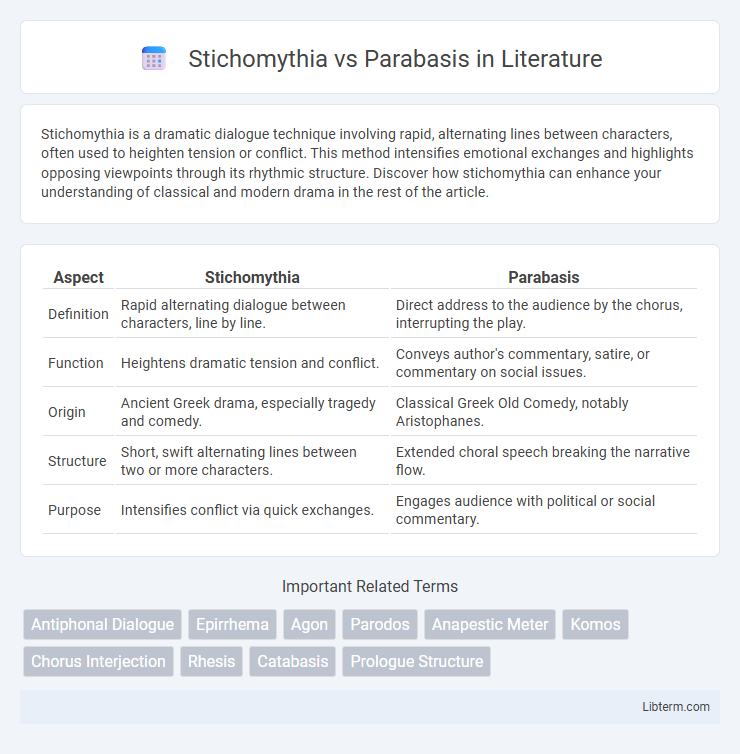Stichomythia is a dramatic dialogue technique involving rapid, alternating lines between characters, often used to heighten tension or conflict. This method intensifies emotional exchanges and highlights opposing viewpoints through its rhythmic structure. Discover how stichomythia can enhance your understanding of classical and modern drama in the rest of the article.
Table of Comparison
| Aspect | Stichomythia | Parabasis |
|---|---|---|
| Definition | Rapid alternating dialogue between characters, line by line. | Direct address to the audience by the chorus, interrupting the play. |
| Function | Heightens dramatic tension and conflict. | Conveys author's commentary, satire, or commentary on social issues. |
| Origin | Ancient Greek drama, especially tragedy and comedy. | Classical Greek Old Comedy, notably Aristophanes. |
| Structure | Short, swift alternating lines between two or more characters. | Extended choral speech breaking the narrative flow. |
| Purpose | Intensifies conflict via quick exchanges. | Engages audience with political or social commentary. |
Introduction to Stichomythia and Parabasis
Stichomythia is a classical dramatic technique featuring rapid, alternating single lines of dialogue between characters, often used to heighten tension and emphasize conflict in Greek tragedy and comedy. Parabasis, key to Old Comedy, breaks the fourth wall as the chorus directly addresses the audience, offering commentary and authorial insights unrelated to the plot. Both methods serve distinct theatrical functions: Stichomythia drives character interaction and conflict, while Parabasis provides meta-theatrical perspective and social critique.
Historical Origins of Stichomythia
Stichomythia, originating in ancient Greek theatre, especially in the works of Aeschylus and Sophocles, is characterized by rapid, alternating dialogue between characters, often used to heighten dramatic tension during conflicts. This technique contrasts with parabasis, which emerged in Aristophanic comedy as a chorus direct address to the audience, breaking the narrative flow. The historical origins of stichomythia highlight its role in intensifying emotional exchanges, reflecting early Greek dramatic traditions focused on human conflict and rhetoric.
The Evolution of Parabasis in Greek Drama
Parabasis, a distinctive feature of ancient Greek comedy, evolved from direct audience address to a complex interaction involving the chorus and playwright, reflecting societal commentary and political satire. Unlike Stichomythia, which is characterized by rapid, alternating dialogue between two characters to create dramatic tension, Parabasis breaks the narrative flow, allowing the chorus to step out and voice collective thoughts or critique public issues. This evolution highlights a shift in Greek drama towards greater audience engagement and the blending of theatrical performance with civic discourse.
Defining Characteristics of Stichomythia
Stichomythia is a dramatic dialogue technique characterized by rapid, alternating single lines between characters, emphasizing conflict and emotional tension. It typically features antithetical statements, wordplay, and repetition to heighten the intensity of the exchange. Unlike parabasis, which involves direct addresses to the audience by the chorus in classical Greek theater, stichomythia serves as a dynamic interaction within the plot, driving narrative momentum.
Structure and Purpose of Parabasis
Parabasis is a structured choral ode in ancient Greek comedy where the chorus directly addresses the audience, breaking the fourth wall to comment on political, social, or literary issues unrelated to the plot, typically featuring elevated language and formal rhetoric. Unlike Stichomythia, which consists of rapid, alternating single lines between characters to heighten dramatic tension and conflict within the dialogue, Parabasis serves as a didactic and reflective pause that conveys the playwright's personal viewpoints. The purpose of Parabasis is to engage the audience intellectually and provide insight into the themes or moral lessons of the play, functioning as a rhetorical device distinct from the narrative-driven, dynamic exchanges characteristic of Stichomythia.
Functional Differences: Dialogue vs. Commentary
Stichomythia serves as a rapid, back-and-forth dialogue technique predominantly used in classical Greek drama to heighten tension and conflict between characters through sharp, concise exchanges. Parabasis, by contrast, breaks the fourth wall by allowing the chorus to directly address the audience, providing commentary, social critique, or authorial insight independent of the main narrative. The primary functional difference lies in stichomythia's role in advancing dramatic interaction and plot development, while parabasis functions as an external interjection that offers reflection or critique without dialogue between characters.
The Role of Stichomythia in Dramatic Tension
Stichomythia, characterized by rapid, alternating dialogue between characters, heightens dramatic tension by accelerating the pace and intensifying conflict during critical moments in a play. This technique contrasts with parabasis, where the chorus directly addresses the audience, offering commentary without engaging in conflict. Stichomythia's rhythmic verbal sparring enhances emotional stakes, revealing characters' intentions and heightening audience engagement.
Parabasis as a Tool for Authorial Voice
Parabasis in ancient Greek comedy serves as a direct address to the audience, allowing the playwright to articulate personal views and social commentary, bypassing the characters and plot. This technique contrasts with Stichomythia, where rapid-fire dialogue between characters creates tension and debate within the narrative. Parabasis functions as a powerful tool for authorial voice, providing insight into the playwright's intentions and enhancing the thematic depth of the performance.
Stichomythia vs. Parabasis: Comparative Analysis
Stichomythia is a rapid, alternating dialogue technique used in classical Greek drama to heighten tension and highlight conflict between characters, characterized by short, single-line exchanges. Parabasis, in contrast, breaks the narrative flow by having the chorus directly address the audience, often delivering commentary or political messages, and is not focused on character interaction. Comparing Stichomythia and Parabasis reveals their distinct functions: Stichomythia intensifies dramatic interaction within the plot, while Parabasis serves as an exegetical or rhetorical interlude that pauses the storyline.
Lasting Influence on Modern Literature and Theatre
Stichomythia, characterized by rapid-fire dialogue exchanges, has influenced modern theatre by enhancing dramatic tension and pacing in plays and screenplays, contributing to dynamic character interactions. Parabasis, originating from ancient Greek comedy where the chorus breaks the fourth wall to address the audience, persists in contemporary literature and theatre through meta-theatrical techniques that engage audiences directly and challenge narrative conventions. Both forms have left a lasting impact by shaping narrative structures and audience engagement strategies in modern dramatic works.
Stichomythia Infographic

 libterm.com
libterm.com